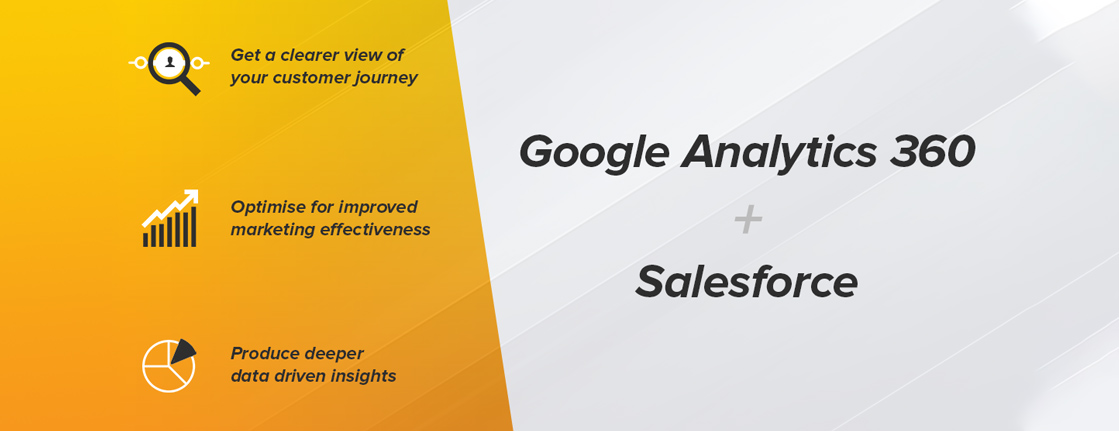Data silos are very real and exist in many organisations which can lead to huge inefficiencies, wasted resources and reduced productivity in any department. While there are many solutions that provide better customer journey analysis and insights; none offer the same opportunities brought by integrating Google Analytics 360 and Salesforce, to create a more unified view of your data.
You can get a clearer view of your customer’s journey
Google and Salesforce have started working together to seamlessly connect sales, marketing and advertising data for the first time. This integration works for both Salesforce products, including Sales Cloud and Marketing Cloud.
Not only will these combined data tools give you a comprehensive view of your customer’s journey, but you will also be able to link online and offline interactions to better understand engagement across multiple channels. For example, you can evaluate the quality of your leads through organic or paid search as well as display or content marketing and optimise your efforts towards those that drive more valuable and quality leads further down the funnel.
You can optimise for improved marketing effectiveness
The combination of Analytics 360 and Salesforce means you can build audience lists and goals that can be sent to Google Ads and DoubleClick. You can then optimise on bids, improve your digital retargeting strategy and find new customers that produce more revenue for your business.
Marketers are now able to see online behaviour, leads or sales in Sales Cloud, as well as Analytics 360 data from those that converted offline and returned to your website to browse further. Thus, improving your strategy by retargeting your customers effectively, and truly understanding their needs, can motivate them to re-purchase, either online or in-store and vice versa.
You can produce deeper data driven insights
This powerful integration will not only help you improve the ROI for your business as a result of your marketing efforts involved, but will also give you insights into understanding how your most valuable customers engage with your digital activities. For example, you can get clearer visibility on whether or not visitors are able to easily find what they are looking for on your website, which can determine the intent to purchase or influence more returning customers to repurchase.
The data made available from this integration will also help you better utilise campaign performance reports as well as create high performing ads for your business. You can then use these insights to report on the number of visitors that enter your site, the number of times they show interest by clicking a ‘call to action’, or the total number of conversions that are recorded.
Understanding Analytics 360 + Salesforce Sales Cloud
This is the process of connecting offline marketing, sales and leads along with online data to boost engagement. The combination of these data sources then gets pushed back into Analytics 360 and Sales Cloud, where the ultimate goal is to give you a comprehensive understanding on the relationship between different traffic sources, online leads and the quality of these leads as they journey through the funnel. Doing so, will provide deeper insights of your customers and allow you to make more informed data-driven decisions for your business’ needs.
Connecting these two platforms together is important in understanding how Salesforce manages and captures data, so you can accurately link your customer’s data to create relevant lead scoring, valuable segments, impactful ad messages, concise campaigns, behavioural re-marketing and measure your ROI successfully.
What this looks like from a customer’s point of view
Take Sarah for example:
- Sarah receives a non-targeted ad about shoes.
- Sarah decides to click on the ad and arrives on a website for shoes.
- Sarah browses through the site, clicking on several products and pages.
- Sarah gains an interest in a pair of shoes she wants to enquire about, and provides her consent to be contacted by completing the online form with her details.
- The shoe company stores her details as a lead in their CRM, which in this case is Salesforce.
- The shoe company previously linked their CRM and Analytics tools together, so when Sarah filled out the online form to request more information, her details got stored in their CRM.
- A sales representative follows up with Sarah by replying to her enquiry.
- As Sarah's purchase journey continues, the sales representative records these milestones in Salesforce.
- Salesforce milestones and opportunities are then passed to Analytics 360.
- If Sarah decides to browse the site a second time at a later stage, Analytics 360 and Salesforce will identify her as a returning customer.
Although the process seems fairly simple, there is an art for extracting and engineering this data in the backend, to ensure you’re getting the information you need when combining these data sources together. If there is just one data point missing or if it hasn’t been properly tracked, the integration will not succeed.
We recommend marketers reach out to a reliable data partner to help accurately integrate the two platforms, so you can create meaningful dashboards and reports for deeper and more actionable insights, analyse user behaviour effectively and optimise your marketing efforts to improve the ROI for your business.
What about Analytics 360 + Salesforce Marketing Cloud?
Marketers who have Salesforce Marketing Cloud will have the opportunity to use the audiences they’ve created in various marketing channels including SMS and email. They can also export campaign data for more robust reporting as well as import marketing event data to augment existing data in Analytics 360.
Datalicious is a premium Analytics 360 reseller. We can help you integrate your Salesforce data or any other CRM tool with Analytics 360 so you can bring out the power of these combined tools, and create reports that drive more successful outcomes for your business. Get in touch with us today at [email protected].



